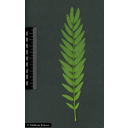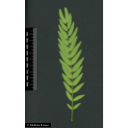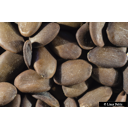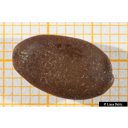Useful information about the taxon (species, subspecies, variety...)
Gleditsia triacanthos L.
Fabaceae (Leguminosae, Papilionaceae)
(APG IV)honeylocust, thorny locust, sweet-locust
Taxon concept: The Plant List (2014), version 1.1
Distribution: East-Central United States incl. Florida; occasionally naturalized in Central and Southern Europe (Iberian Peninsula, France, Italy, Balkan Peninsula)
Size: 21 - 43 (m)
Gleditsia triacanthos L. - Accepted: Gleditsia triacanthos L. bei Zander 2008; Familie: Caesalpiniaceae (Zander 2008)Gleditsia triacanthos L. - Accepted: Gleditsia triacanthos L. bei The Plant List (2010); Familie: Fabaceae (Leguminosae, Papilionaceae) (APG III)Gleditsia triacanthos L. - Accepted: Gleditsia triacanthos L. bei The Plant List (2014), version 1.1; Familie: Fabaceae (Leguminosae, Papilionaceae) (APG III)Gleditsia triacanthos L. - Accepted: Gleditsia triacanthos L. bei The Plant List (2010); Familie: Fabaceae (Leguminosae, Papilionaceae) (APG IV)Gleditsia triacanthos L. - Accepted: Gleditsia triacanthos L. bei BfN Checklist Flora DE; Familie: Fabaceae (Leguminosae, Papilionaceae) (APG IV)Gleditsia triacanthos L. - Accepted: Gleditsia triacanthos L. bei World Flora Online - APG IV (Angiosperms); Familie: Fabaceae (Leguminosae) (World Flora Online - APG IV (Angiosperms))
- Flowers
- polygamodioecious; flowers in racemes
- Flower ecology
- pollinated by insects (bees and flies)
- Life form
- tree
- Leaves
- paripinnate
- Foliage persistence
- deciduous
- Fruits
- coriaceous pods (legumes)
- Fruit ecology
- animal-dispersed (endozoochorous) (cattle and horses)
- Root type
- deep-rooted (strong taproot)
- Natural occurrence (habitat)
- upland woodlands and borders, old fields, fencerows, river floodplains, hammocks, moist bottomlands, rocky hillsides
- Vegetation typ and synecology (plant community)
- temperate, mixed mesophytic deciduous forests
- Constraints according soil conditions
- somewhat tolerant of salinity
- Constraints according moisture
- drought-resistant
- Constraints according radiation (light)
- intolerant of shade
- Constraints according habitat
- highly tolerant of flooding
- Chemical characters
- contains more than 60 phytochemicals, thereunder polyphenols, triterpenes, sterols and saponins
- Life span
- relatively short lived (at maximum 125 years)
- Usage
- used in windbreaks; as ornamental tree
- Phytopathogenic organisms
- is severely infested by the honeylocust plant bug Blepharidopterus chlorionis
- Altidudinal lower limit (sea level in m)
- 760
- Altitudinal higher limit (sea level in m)
- 1,520
Gucker, C. L. (2011): Quercus macrocarpa. In: Fire Effects Information System, [Online]. U.S. Department of Agriculture, Forest Service, Rocky Mountain Research Station, Fire Sciences Laboratory (Producer). See: https://www.fs.fed.us/database/feis/plants/tree/quemac/all.html; Mauri, A. et al. (2016): Quercus frainetto in Europe: distribution, habitat, usage and threats. In: San-Miguel-Ayanz, J., de Rigo, D., Caudullo, G., Houston Durrant, T., Mauri, A. (Eds.), European Atlas of Forest Tree Species. Publication Office of the European Union, Luxembourg.; Oaks of the World (Accessed: 2018): Quercus macranthera. See: http://oaks.of.the.world.free.fr/quercus_macranthera.htm; Pritsch, Günter et al. (1985): Bienenweide.. Neumann-Neudamm, Melsungen; Pritsch, Günter et al. (2007): 200 Trachtpflanzen erkennen und bewerten.. Kosmos, Stuttgart; The International Plant Names Index (2009). Published on the Internet http://www.ipni.org; Courtesy to IPNI, 2009. Exported from IPNI at date: 2009-09-22 20:17:51;
Diese Webseite verwendet Google Maps, um Karten und Standorte von Pflanzen in den Hohenheimer Gärten anzuzeigen. Dadurch werden unter Umständen Daten an Google weitergeleitet, was mit einer Verarbeitung Ihrer personenbezogenen Daten verbunden sein kann. Die Datenschutzerklärung von Google finden Sie hier: Datenschutzerklärung von Google
| Sex | Standort | Accession number | Planting year | Donation | IPEN | Lat. | Long. |
|---|---|---|---|---|---|---|---|
| Parzelle O | EG-O-010-23698 | XX-0-HOH-EG-O-010-23698 | 48,7085049516 | 9,2098227663 | |||
| Parzelle S | LG-S-051-23603 | 1998 | + | XX-0-HOH-LG-S-051-23603 | 48,7067605177 | 9,2117199699 | |
| Parzelle H | SP-HB-009-1760 | 2017 | XX-0-HOH-SP-HB-009-1760 | 48,7106148042 | 9,2135572968 | ||
| Parzelle H | SP-HB-010-10050 | 2017 | + | XX-0-HOH-SP-HB-010-10050 | 48,7105799195 | 9,2135200134 |




